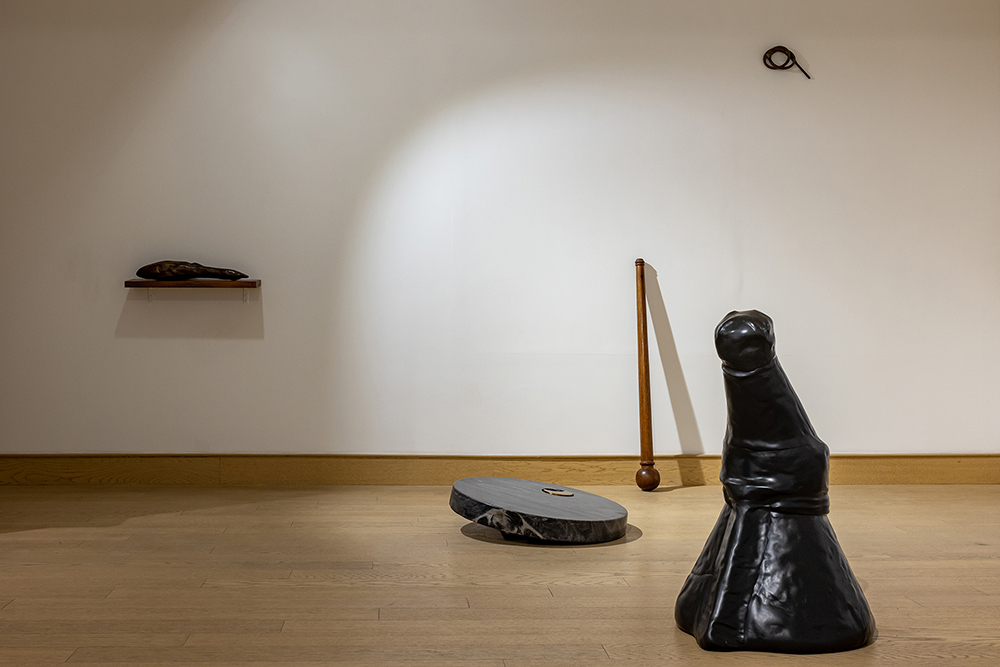
Baggage From ‘The Longest March’
Baggage From ‘The Longest March’
Year-2023 @Nature Morte
For this exhibition, the artist creates enigmatic three-dimensional objects in various materials—bronze, wood, stone, and M-Seal, an epoxy putty used to repair objects, fill cracks, and plug leaks. Jha’s sculptures resemble everyday objects, yet their likeness is fleeting and elusive. Throughout the exhibition, a conversation unfolds between these small-scale sculptures, inviting viewers to reimagine their own sensory experiences and memories. The “baggage” in the exhibition’s title refers to the myriad objects we carry, both physically and psychologically, through our lives. “The Longest March” alludes to the recent pandemic lockdown, a time when everyone had to reevaluate their daily lives. The artist explores the idea of returning in both time and space. Within his exhibition, Jha performed as a magician, narrating the stories of these objects, while their shapes and sizes continuously shift.
The exhibition follows the artist’s participation in the exhibition “Very Small Feelings,” which was curated by Akansha Rastogi and Diana Campbell and first appeared at the Dhaka Art Summit (February 3–11, 2023) and then the Kiran Nadar Museum of Art in New Delhi (July 4–October 3, 2023).
Returning to Earth – A Kinder Search for Home
(Exhibited at Kiran Nadar Museum of Art_2022-2023)
Commissioned by Samdani Art Foundation and Kiran Nadar Museum of Art
Returning to Earth – A Kinder Search for Home
(Exhibited at Dhaka Art Summit (DAS) 2022-2023)
Commissioned by Samdani Art Foundation and Kiran Nadar Museum of Art
Murari Jha stages a landscape that we carry within us—seen, felt, and absorbed. This work emerged from his reflections on the desperate journeys of millions of migrant laborers who braved all odds to return home during India’s first COVID lockdown, even at the cost of their lives. Thus, returning to the earth becomes a gentler search for and understanding of home. Jha encourages us to immerse ourselves in his scattered arrangements, replenishing memories of our growing-up landscapes and our relationships with the sun, moon, mountains, earth, trees, water, and animals. By inviting and accumulating observations, stories, and personal and social associations with each element—alongside colloquial phraseology and idioms—Jha invites visitors to interact, play, touch, speak, and write on a provided slate within the installation. Working across mediums such as performance, sculpture, and painting, Jha’s art reveals the personal as political, the performativity of body and object, and the psychological processing of everyday occurrences and environments.
समय पहाड हो गया हैl
‘Samay Pahad Ho Gaya Hein’ _A memory of time.
Installation + Durational Performance, Size -268x129x100 inch
The live art at Dutch Warehouse, curated by HH Artspace in collaboration with the Kochi Biennale Foundation, was a powerful exploration of time and memory through performance.
Held from early morning until night, the performance encapsulated the daily labor actions of repetitive sounds from anklet bells and deliberate body movements, combined with a slow progression of intense physical presence that shaped the space into a performative sculpture resembling a mountain. This mountain symbolized the “holding time” of past memories, inspired by a metaphor from Jha’s mother, a North Indian phrase: “Samay Pahad Ho Gaya Hein,” which means “Time has become a mountain,” expressing the absurdity of time.
This mountain also invited spectators to become performers themselves, allowing them to sing, talk, and experience the texture, warmth, and smell of the space, transporting them back in time. Jha’s performance intricately focused on the relationship between the body, time, and structure within the context of performance, creating an immersive and reflective experience for all involved.